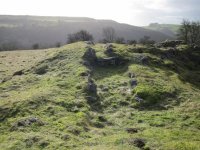Madness
New member
I visited Slaley Sough for the first time last night and was quite suprised at the extent of the workings.
I find it intriguing that such extensive workings exist where it appears negligable amounts of ore exist. I'm left pondering the following questions:-
Why would you create such passages if you were only prospecting for ore?
Why wasn't the entrance level enlarged to the size of the other passages? This would surely make waste removal easier.
Why is the entrance so small and difficult to get to? It seems an awkward way to get everything into and out of the mine (rails, wagons etc)
Given the evidence of some sort of rails in the larger level, why isn't there evidence of any in the entrance level?
I've heard that the internal shafts/raises are blind. Markpot tells me he's climbed one, and I've read that Thunder Shaft is blind, but I wonder if all the raises have been fully explored.
If anyone has any information that they can add it would be appreciated. In my mind, it appears that there's more to Slaley than meets the eye.
I find it intriguing that such extensive workings exist where it appears negligable amounts of ore exist. I'm left pondering the following questions:-
Why would you create such passages if you were only prospecting for ore?
Why wasn't the entrance level enlarged to the size of the other passages? This would surely make waste removal easier.
Why is the entrance so small and difficult to get to? It seems an awkward way to get everything into and out of the mine (rails, wagons etc)
Given the evidence of some sort of rails in the larger level, why isn't there evidence of any in the entrance level?
I've heard that the internal shafts/raises are blind. Markpot tells me he's climbed one, and I've read that Thunder Shaft is blind, but I wonder if all the raises have been fully explored.
If anyone has any information that they can add it would be appreciated. In my mind, it appears that there's more to Slaley than meets the eye.



